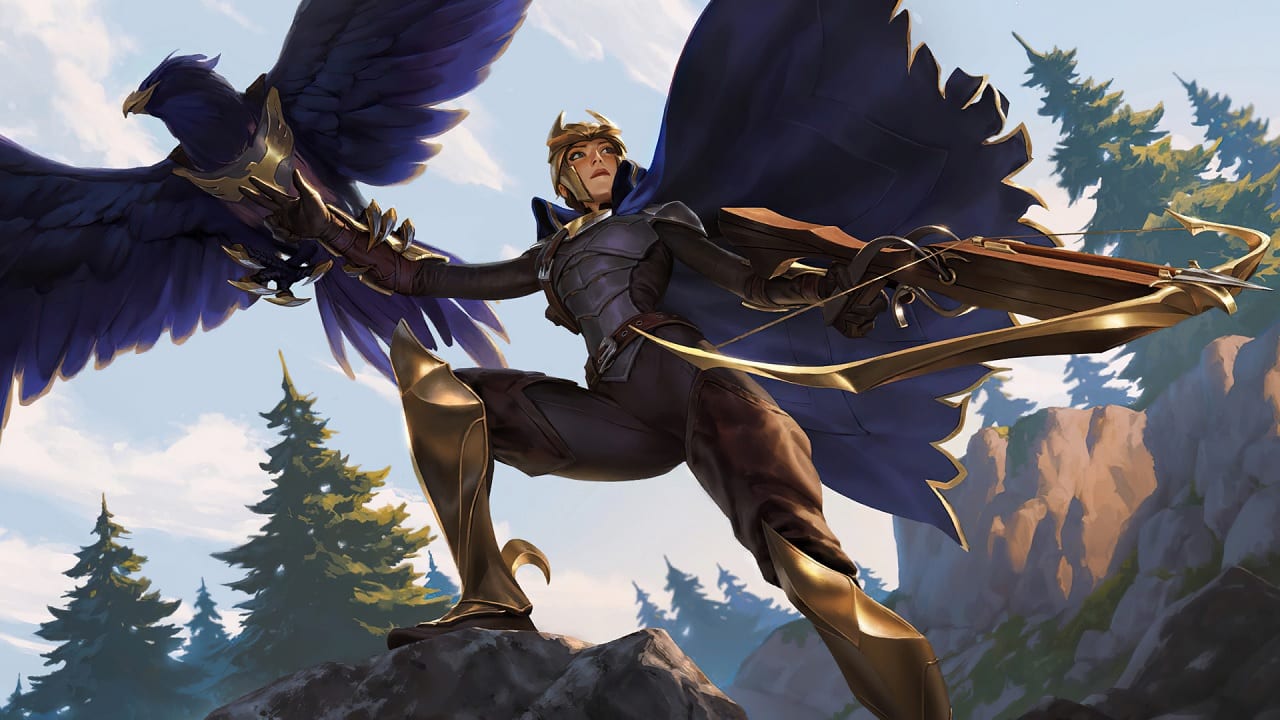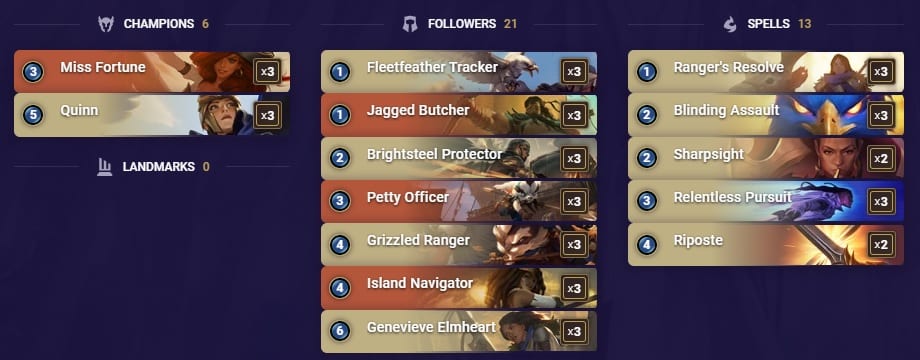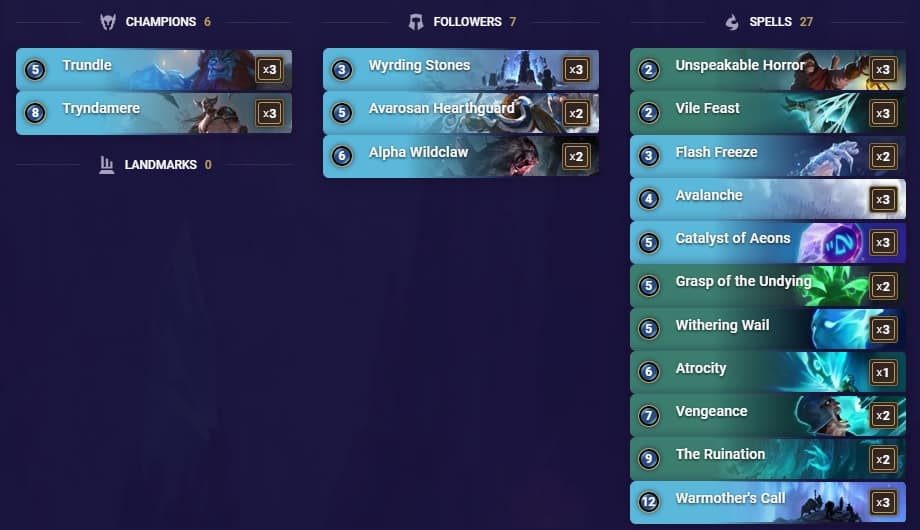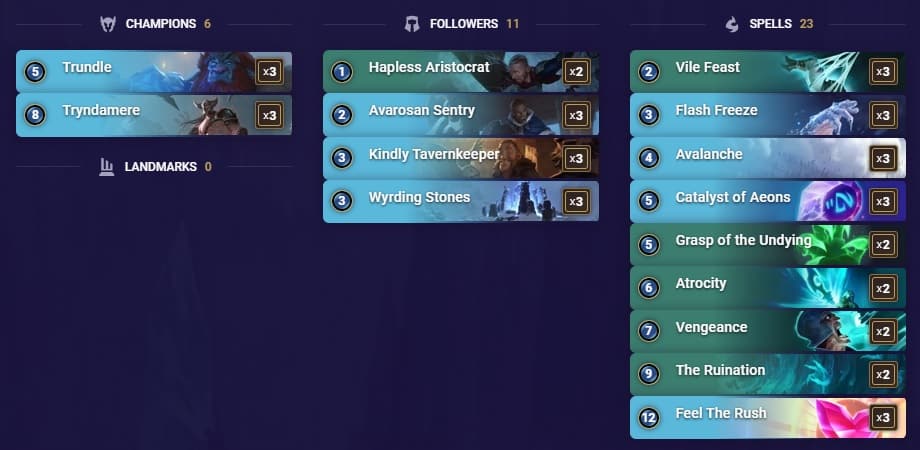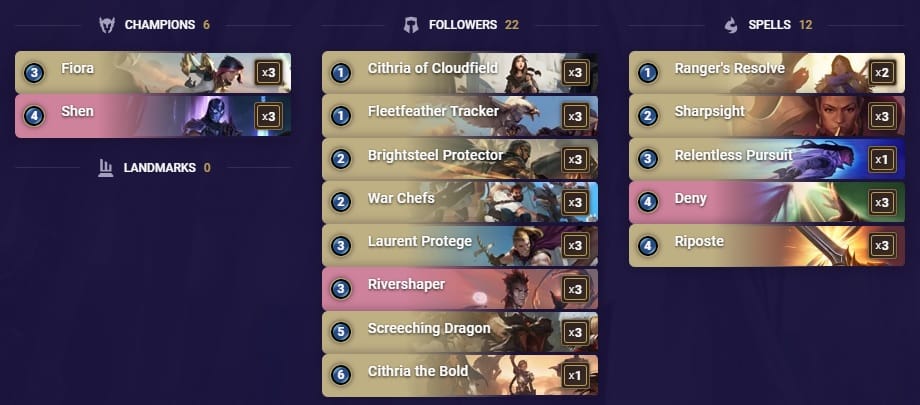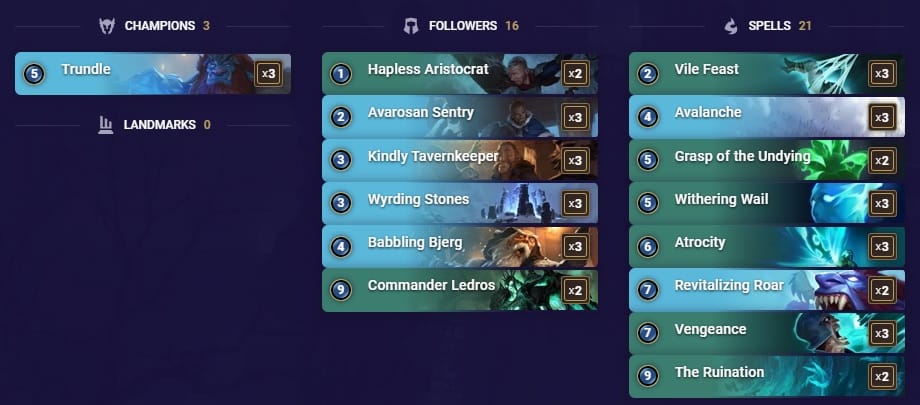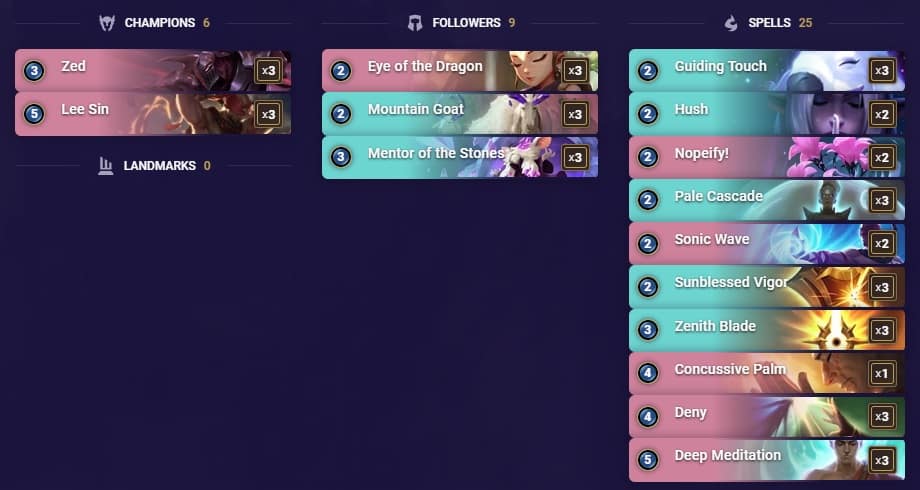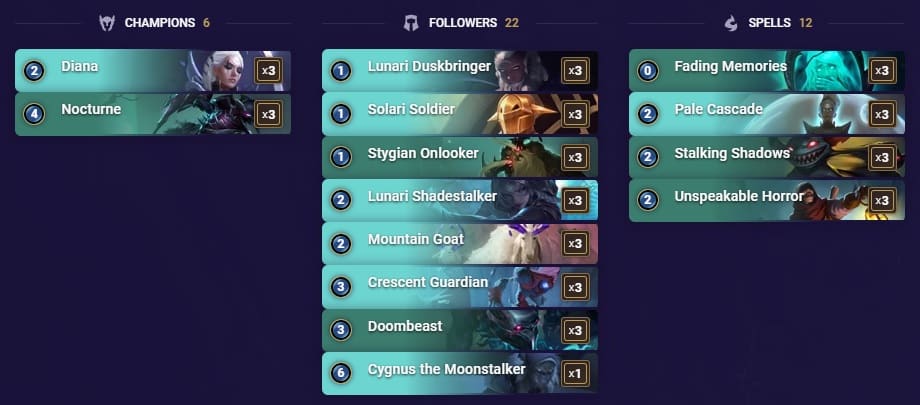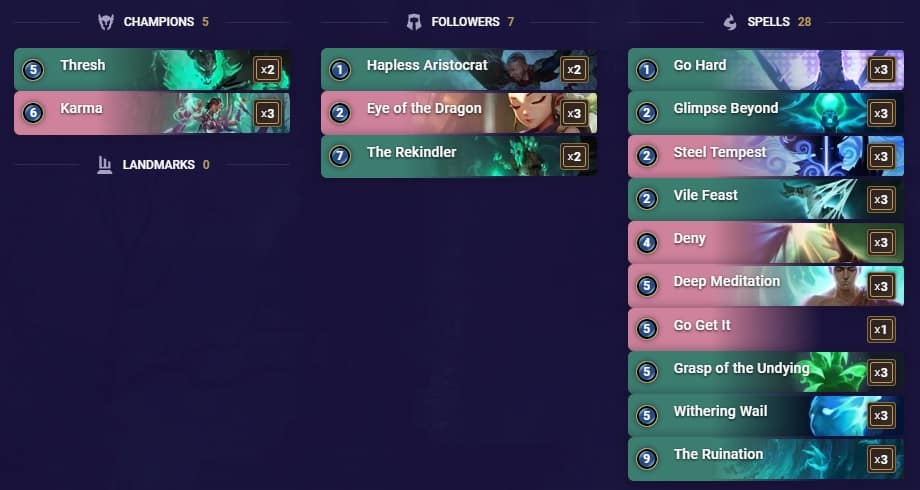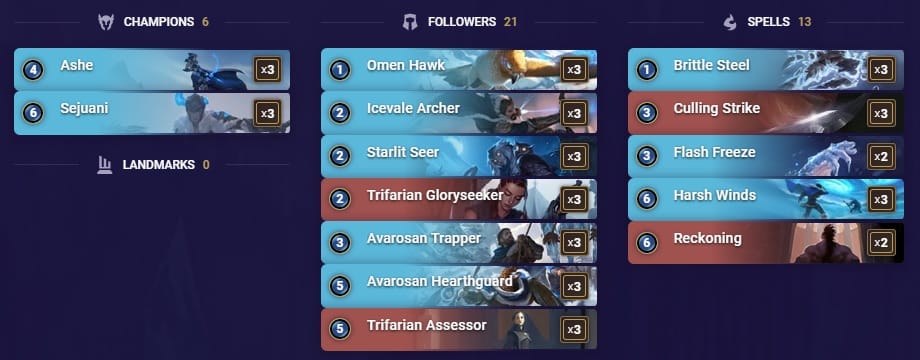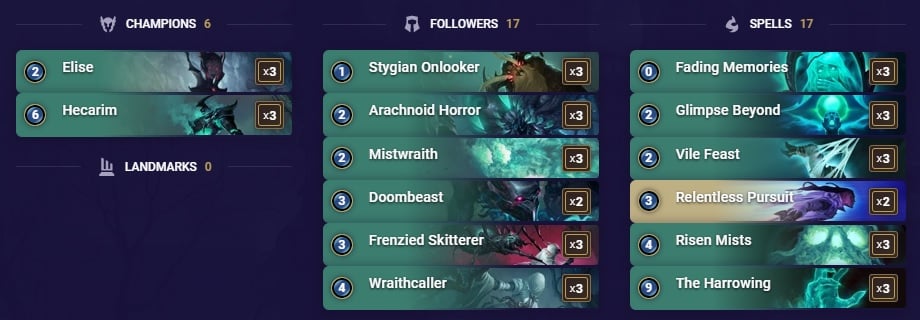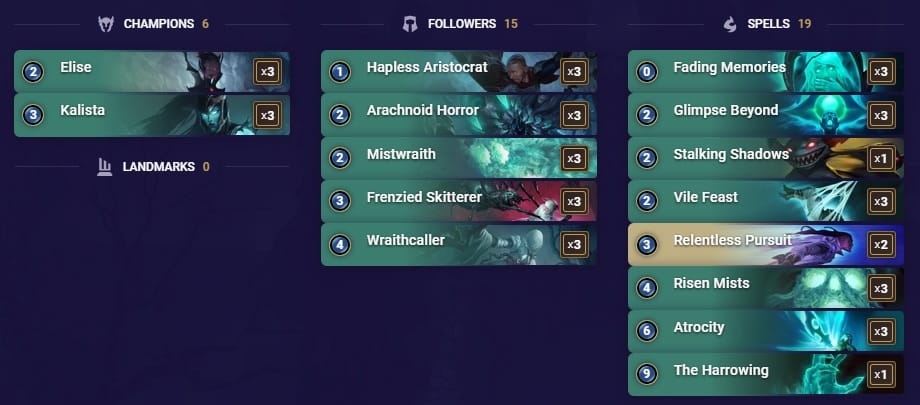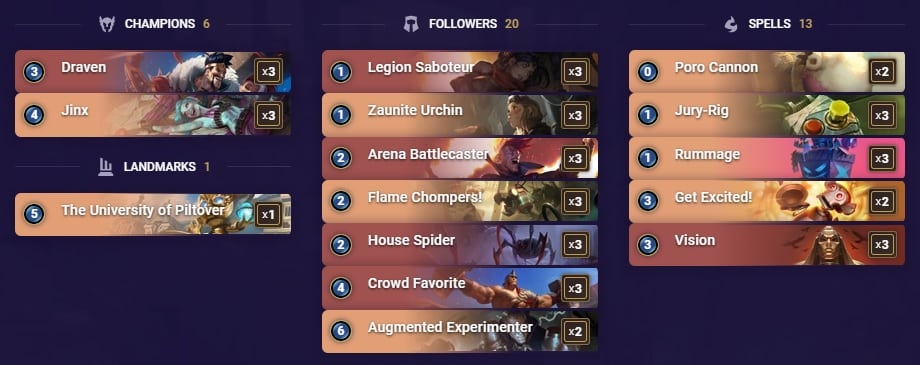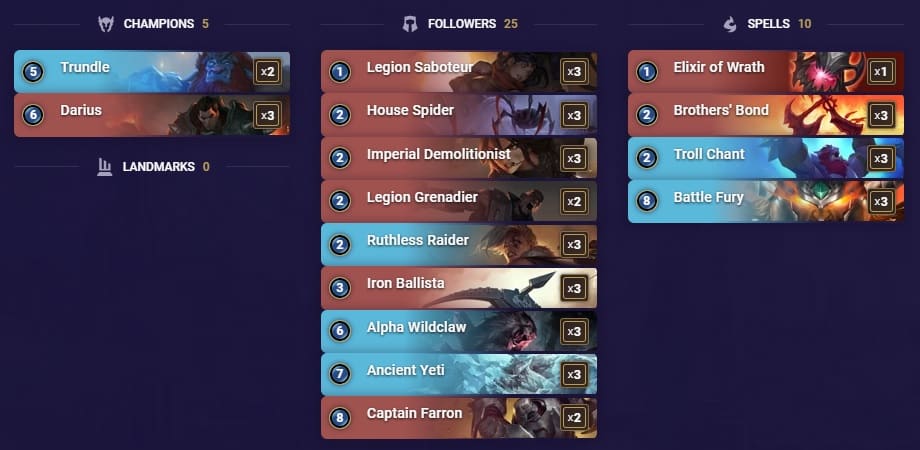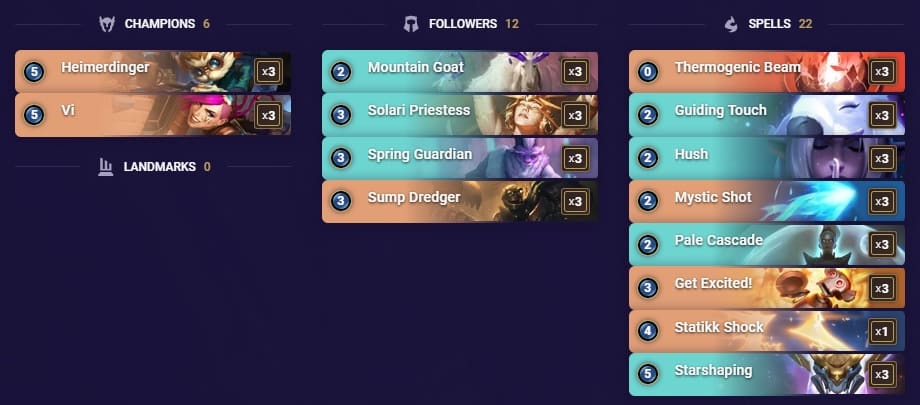Welcome to TLG’s newest meta snapshot for Legends of Runeterra, a series in which we give you our insight on the best decks in the higher ranks of the ladder.
Every Sunday, we discuss the decks that are part of the week’s meta and rate them on a scale of 1 to 5 stars. We also look at the evolution of said decks’ ratings across weeks and draw conclusions regarding the current state of the game, all of this so you can delve into your own ranked journey with a head start.
This week, the meta is centered largely around MF Scouts and SI control decks (especially Feel The Rush). Scouts take the top spot, as they consistently beat all the SI control decks from last week. We’re starting to see the SI decks going back to running a full set of Grasp of the Undying as a response to this.
For those who enjoy countering the top decks of the meta, Fiora-Shen could be a good pick. The deck is able to Deny the SI control decks’ win condition while applying pressure with units. Against Scouts, Fiora-Shen can gain the upper hand if they manage to value-trade key units like Miss Fortune.
With so many Scouts on ladder, Zed-Lee is a lot weaker. Some of the bonus decks from last week, namely Spooky Karma and Mono SI, have made it into the tier list. The Shadow Isles are certainly having a great time at the moment!
If you have any questions, feel free to drop by our Discord. Best of luck on your climb!
Graphics: WellMax81
Editing: Crixuz, Den, Wusubi, Sebodunum, ShadowplayRed
EU Consultants: CastMin, Dartill, Kuvira, Ultraman, Zezetel
NA Consultants: Earlmeister, Glop, NicMakesPlays, RattlingBones, Stan, Kozmic, RiceFT, Zenaton

CIBQGAIABEKR2BACAYEBMOR6AUBAAAQGA4EQUAQBAEACKAIDAAHAA
Scouts are pretty much an ever-present deck in Runeterra; its highly adaptive core allows it to successfully shift into a powerful form in multiple metas. This new version represents another such form, transitioning from a more simple one that was played on curve to a slightly more sophisticated list that instead emphasises playing with spells and gems. The list values the survival of its units over a great, strong curve.
That being said, the deck clearly still benefits from a good curve, but you can afford to miss a turn, or even take advantage of that missed turn in order to gather mana for a later use of Sharpsight, Ranger’s Resolve or Riposte.
Aimed at helping Quinn and Miss Fortune survive, this list mainly mulligans for MF, and can pull off wins in the most desperate situations (as long as it doesn’t lose the board) thanks to Relentless Pursuit and the champions’ interaction. In addition to this positive scenario, you can also pull out regular Demacia wins by merely curving out against less reactive opponents.
Considerations: Given that the deck has historically been known as Bannermen, it’s surprising not to see the aforementioned card in the list. This is mainly due to the fact that the deck doesn’t want to play on curve against most decks in the meta, as it wants to keep MF alive by using Ranger’s Resolve or Sharpsight, weakening the Bannerman’s effect in some, if not most cases.
Vanguard Bannerman can still be added to the list, if you want to run a more purely Demacian version; in this case, you would add Laurent Protege and Cithria of Cloudfield.
Lucian-Senna are known as a more punchy version - they can replace Petty Officer and Quinn if you keep facing Aggro decks.
Finally, Cithria the Bold could replace Genevieve Elmheart, and we advocate for you trying out variations including different amounts of each of them until you find a balance with which you are comfortable. Cithria the Bold will mainly serve against minion-based control decks and will usually be less useful against AoEs, as the buff doesn’t take effect immediately.
Warmother
CICACAYBAYAQGBICAIAQKHJIAUAQCDAUC4QSOAQDAEAQCGRJAMAQKAIPGYAQCAIFDE
Warmother and Feel The Rush are the two main SI control decks. They share the characteristics of (1) Ramping, (2) inclusion of 12 mana spells, (3) use of control tools like Avalanche and The Ruination, and (4) a desire to play Trundle on T4. Their differences stem mainly from the nature of their 12 mana spell. Warmother’s Call summons a random unit from your deck both when you play it and at the start of every turn. This restricts deck-building because you’re forced to only play big units, otherwise you put yourself at a very real risk of summoning units that don’t sufficiently impact the board.
As a result, Warmother decks don’t have any T1 or T2 units, instead relying on spells such as Vile Feast and Unspeakable Horror to stabilize the board. This makes them predictable in the early game, with only two paths they can take. The first option is to Ramp on T3 and play Trundle on T4, the second option is to play Avalanche, Withering Wail or Grasp of the Undying on T3/T4. The deck can’t do both things at once.
Against Aggro (with the exception of Discard Aggro), it’s futile for Warmother to try and Ramp to play Trundle on T4. This would encourage the opponent to go wide - Avalanche being at Slow speed means that you’re soaking 10 damage even with Trundle. Thus, when facing Aggro, it’s usually more profitable to mulligan for all of your control tools rather than trying to Ramp.
Feel The Rush
CIBQCAIFFABAGAIGCYDQCAIBAMGBIIJHGIAQKAIFAEHRSKZWAA
Feel The Rush, on the other hand, doesn’t have a deck-building restriction, as it always summons 2 champions - in this instance, Trundle and Tryndamere. This gives the deck more liberty to include low impact units that act as very effective chump blockers, namely Hapless Aristocrat and Avarosan Sentry. Likewise, against Aggro, it might not be a good idea to completely skip T1 and T2 just to ramp and play Trundle on T4. Instead, you want to mulligan in search of an Avalanche.
One tip when playing Feel The Rush decks is to try to play around the threat of The Ruination. You can do this by ensuring that Tryndamere doesn’t level-up. If Tryndamere is flipped by the time you play Feel the Rush, The Ruination can lose you the game, as Tryndamere will no longer revive.
In the late game, the biggest difference between Warmother and Feel The Rush is that the former is slower. Warmother’s Call works over multiple rounds, whilst Feel The Rush is higher impact, but only summons the two champions once. This might be why Feel The Rush is so popular now. Yet, Warmother remains advantageous, as it allows you to grind out your opponent with the minions coming every turn (and spells to protect them), making it a safe bet for the late game.

CEBQOAIABEFR2JJHFMWQEAYAAYHAGAICEAVTCAIBAIAAOAICAEABKMY
Fiora-Shen is in essence a Midrange deck because it tries to set-up 2-for-1 trades. This particular list doesn’t run Concerted Strike and Single Combat. It instead tries to be an aggressive Midrange deck with Rivershaper as a value engine, drawing us multiple spells and Deny to counter high-impact spells like Warmother’s Call and board wipes such as The Ruination.
However, unlike most Midrange decks, you don’t necessarily want to play on curve. You want to try and maximize the value of your units by pairing them with cards that synergize together. Your mulligan will depend heavily on these pairings rather than playing on curve. Some of the good pairs are: Fleetfeather Tracker & Brightsteel Protector, Shen & Fiora and Shen & Rivershaper. In general, if you’re able to kill a unit for free in the early game, for example using Fleetfeather Tracker and Brightsteel Protector, you’re in a good spot to win the game.
Don’t panic if you miss some of your early units, as the deck has the potential to make a big comeback due to its 2-for-1 nature. Banking spell mana is usually a good idea rather than making cheap early game plays that don’t impact the board and leave you vulnerable without the ability to play any protection spells due to being tapped out of mana.
Against SI control decks, it’s crucial to mulligan for Deny. You have three copies of Deny and no other card can fulfill its function. If possible, save Deny specifically for Warmother’s Call or Feel The Rush. Don’t be tempted to use it to save Fiora (for example) UNLESS doing so puts you in a position where you’re likely to finish the game before the opponent ever has the chance to play a Warmother’s Call or Feel The Rush.
CIBQCAYBAYCACBIBDEOSQBIBAEBQOFBBGIBACAYBAQCACBIPEEVTMAA
This list excels at withstanding the Aggro decks. AoE board wipes like Avalanche and Withering Wail, combined with healing, help you survive against Aggro - but don’t keep your high-cost win conditions (e.g. Ledros) in your opening hand. With more Aggro and Midrange decks in the meta, Trundle-Ledros has some decent matchups. Being more flexible than its Warmother and Feel The Rush counterparts, the list can include more defensive and healing options to stay alive during the mid game.
With the recent addition of Babbling Bjerg, the list now finds Ledros more consistently and can close out games with Atrocity before falling behind other control decks in the late game. Glimpse Beyond is another consideration to draw even more cards, however the 3/3 body of Babbling Bjerg also helps with setting-up Avalanche or Withering Wail.
CEBQGAQCAMDASBQDBENSGKJTLRRAEAICBEYQGAIDBFKQCAYCCQAQEAQIAEAQEAQF
After several weeks of dominance, Lee Sin has left the top spot of our snapshot. His nerf finally impacts the list, as more Aggro decks came back into the meta. We now consider it as a very good Tier 2 deck. The meta has become a bit faster, which hasn’t helped its matchups overall. In this way, Zed-Lee has decreased in its rating, but remains a relevant contender.
In the current situation, Zed and Eye of the Dragon are slowly becoming the real stars in the list, as they’re the most important cards to aid a defence against faster builds. These two help to stabilize the early to mid game and buy enough time to set-up your Lee Sin in more favourable conditions.
The newly-adapted list now features Sunblessed Vigor, as it’s key in safeguarding Zed in the much more frequent early game combat that he will have to engage in. It’s also a good answer to an early Avalanche or Grasp of the Undying from the SI control decks that have been increasing in popularity for the past couple of weeks. With Lee not being the only important card within the archetype anymore, players should aim to incorporate greater flexibility in the way they approach their game plan.
CIBQCAIFF4CQGBICAMCAKBQHAMESGOCJLBMVYXQAAEAQGCJP
Nightfall is an aggressive deck with many tools to kill its opponents. However, unlike your traditional “Aggro” deck, it generates sufficient value to sustain itself in the long run, allowing you to attain clutch wins in the late game. It’ll take some time to learn how to pilot this deck well, since it requires a lot of decision making and planning ahead.
Manage your resources wisely, get a little creative with Nightfall enablers (the incredibly powerful Stalking Shadows being one of them) and you will be rewarded by this sleeper-OP deck.
CICACAYFCABAEAQDBEBQCARJFYYQKAIFB4OSQMJWAEBQCBIUFM2ACAIDAILA
This archetype came back with the release of Go Hard, a card that has an incredible synergy with a flipped Karma. The addition of another new KDA card, Go Get It, gives the deck some crazy possibilities to duplicate and abuse Karma with The Rekindler.
The main focus of the deck is to slow the pace of the game until you can level-up Karma by reaching Illumination. From there, Karma’s passive should take over the game. Being able to Deny cards like Feel the Rush is the main reason why the deck has sharply rose in popularity last week. Against Aggro decks, you should have more than enough defensive tools to control both the board and your health count, making Aggro your overall best match up in the meta.
Spooky Karma should be seen as a work in progress for now. Many players have posted lists with different ideas and directions for the deck; the list posted here is our view for the archetype. We chose to build it around the early game stability and allowing a solid draw engine to go off while slowing down tempo. If you can withstand the opponent’s pressure long enough, the value will come on its own. Thus, your focus should be to stay alive and draw cards until Karma can get truly spooky.
CIBQCAQBAIBQCAYED4QQQAIBBMLB4IBGFEVDAAQBAEAQCAIBAM2QA
The deck hasn’t changed too much from its old self, but the meta is a bit weaker to the Freeze mechanic, which gives you a few good matchups. Ashe-Sejuani is great against Scouts due to its ability to win most 1-on-1 trades. Having access to Reckoning as an AoE board clear gives the deck a good way to combat the meta.
SI control with The Ruination and the occasional Aggro hold Ashe-Sejuani back from becoming a top contender, but Midrange players should be glad the archetype is back to a playable level.
Hecarim
CIBAEAYFAMGQUAIFAMHBAJZIFIXTCNJYAIAQCAAVAEBQKBQA
Already mentioned in our bonus decks section last week, the Mono SI archetype continues to see modifications. Other than the Hecarim build, Atrocity has seen some play, sometimes paired with Darius, or just with Mistwraiths in lists that aim to maximize their attack through Kalista and Fading Memories, for example.
Considerations: The version with Hecarim and three copies of The Harrowing would be the more board-focused one, and tends to do better against decks that experience difficulty in dealing with wide boards even if they’re at full health. Relentless Pursuit provides an extra opportunity to attack with your Fearsome units. The core of the deck is Mono SI and any other region can be enlisted to complete the build.
Darius-Atrocity usually goes for a more direct damage-oriented approach, where the goal is to get the opponent to 10 health so Darius evolves and then swiftly play Atrocity to finish the game. This variation works better against decks without a significant healing capacity, so they can’t get back the health they lost in the early game.
Kalista
CIBACAYFBUFQCBIOCAMR4JZIFMXTCNJYAEAQCAAVAIAQCBIDAEBQKBA
Kalista-Atrocity builds are kind of a hybrid, where you have the luxury of both a very solid board presence as well as a powerful finisher in Atrocity onto a buffed-over-time Mistwraith. The hybrid status of this deck allows you to do a lot of tinkering with it. Relentless Pursuit is a safe inclusion, Atrocity and The Harrowing as well - the former making the deck more damage-centric, the latter making it more board-centric.
CEBAIAYGAQDQQDYHAMER2IZNGM2DOVICAEBQMCICAMETYYQBAEBQSEY
Tahm-Soraka is a Midrange combo deck with the Star Spring landmark as its primary win condition. You want to curve out with self-damage units like Crusty Codger, Boxtopus and Fortune Croaker, supported by healing cards (Star Spring, Guiding Touch) to protect your board and get the maximum value from it. Shakedown allows you to force favorable trades and to manage the damage you take, helping to accelerate your Star Spring healing.
The list has a glaring weakness to The Ruination, which the meta is seeing a lot of right now given the prevalence of SI control. It’s also vulnerable to Fearsome units, which again, are seeing a rise in popularity with the Mono SI decks. The vast majority of Tahm-Soraka’s units are below 3 power, so you will struggle against Mono SI’s early game pressure.
CIBAKAIEAEGBYKBNAYAQGBYJCQTSQNYCAEBQIEQCAECA2JYBAEBQIAI
Fast & Furious, this deck doesn’t have the time to play around. Throw away your whole hand and take advantage of the freebies on your Discard-oriented cards and hope for the best. With Draven as Dominic Toretto and Jinx as Leticia Ortiz, call your friends and start the race. Vision serves as the nitro in your engine, get some and you’ll power up your cards. This deck is hit-or-miss, so get ready for quick wins and devastating defeats.
Discard Aggro is a deck that has to high-roll. If you high-roll, it can defeat anything. However, the prevalence of Withering Wail in the meta prevents it from achieving a higher rating.

CICACAYGAEBACBI5FABAEBIIBICAEBRFF42TQAYBAICQOAQCAYOSYAYBAUARSNQBAEBAMJY
If you enjoy having explosive turns where you can jam tons of huge units, you should definitely play this deck! It aims to survive the early game with healing while working towards getting Deep by tossing cards. Once you get there, stabilize the board with large Sea Monsters and put your opponent on the clock when Maokai levels-up.
The Slaughter Docks landmark performs better than expected, aiding your journey to going Deep and providing decent tempo if played when you are Deep. Would you like a Fresca?

CIBQEAQDAQCQIAYJDQRVQWIGAEBQECYPCQTDOAICAEBQSDIA
Nox-Targon Aggro takes advantage of Overwhelm. The deck has an easy time going wide with low-cost units like House Spider. To exploit this trait even further, you have cards like Decisive Maneuver and Crowd Favorite. It definitely isn’t a straightforward Aggro deck, as it features both Daybreak and Nightfall units.
The most difficult aspect of piloting Nox-Targon Aggro is figuring out the most efficient way to enable your Crescent Guardian. For Nightfall, consider keeping Draven in hand to generate Axes, which allow you to proc Nightfall for free and at Burst speed. The list includes three copies of Whirling Death, and possibly much more if you draw multiple Dravens. Use them to take over the board in the early game and then snowball with your tempo. (Deck from ImpetuousPanda)
CICQCAQBAYAQGAICAIBAGBAFAMAQCBI2D4CACAYZEYUDOAQBAMAQMAQBAMSTGAIBAEBRW
This Overwhelm deck includes a lot of buffs, taking advantage of the fact that there aren’t many cards that can deal with huge Overwhelm units right now. The plan is to play units on curve, before finishing the game with a great Overwhelm attacker like Darius or another Overwhelm unit with Battle Fury. Ancient Yeti looks a bit deceiving, but is a good keep in your opening hand. Thanks to his ability, you’re usually looking at playing him on T4. Keep in mind that you don’t always want to play him that way, sometimes it’s beneficial to play him when he costs one or zero mana.
Many of the units in the list have a high natural attack. For example, Ancient Yeti has a base attack of 5 and Trundle has a base attack of 4. This is extremely relevant because of the interaction between Battle Fury and Hush. Usually, your opponent tries to chump block your unit, and then you could respond by playing Battle Fury which usually threatens lethal. Even if the opponent has Hush, it doesn’t negate the base attack of your unit, and you’re typically looking at getting a meaningful value trade.
The second crucial combat trick is Troll Chant. You should always be looking to deceive your opponent into making trades and play Troll Chant at the last minute to keep your units alive while killing theirs. Troll Chant work best when you have at least two attackers, both of which your opponent thinks they can kill. Your units having Overwhelm means that not only are you winning the board by using Troll Chant, but you’re also dealing unavoidable Nexus damage.
The list also plays Captain Farron, causing chaos for the opponent whilst they’re trying to stabilize. (Deck from Rickorex)
CIBQCAQEBACQCBA3EYTTIOAHAMESGM2QKRKVYYAAAEAQCBA7
Thanks to Targon’s support, Heimerdinger can thrive again, but in a more secondary role than his usual self. Say goodbye to the Heimerdinger high-roll winning games on Turn 5 and instead welcome having a great value tool on top of an overall solid base. Vi steals the spotlight, as the Spring Guardian will help her stay healthy while trading and dealing damage to the opponent.

